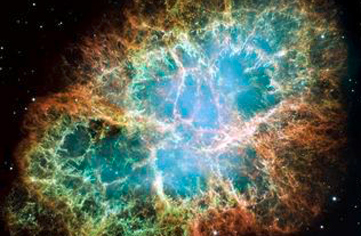Half-life of iron-60 surprises researchers
26.08.2009 —
The decay of radioactive elements in the universe provides astronomers with valuable findings on the chronological course of cosmic events. If astronomers succeed in determining the proportions of the starting and decay products involved, they can suggest the point in time when the radioactive process began – provided that the half-life of the relevant material is known.
A group of scientists from the TU München and the Excellence Cluster Universe along with their colleagues from the Swiss Paul Scherrer Institut (PSI) have now succeeded in determining the half-life of iron-60 more precisely than ever before. During their research they ran across a real surprise: The half-life of iron-60 of 2.6 million years clearly exceeds the hitherto known value of 1.5 million years (Physical Review Letters, Vol. 103, No. 7).
The rare, radioactive iron isotope iron-60, whose nucleus contains four neutrons more than the most frequent iron-56, interests scientist for many reasons. The radiation of its direct decay product cobalt-60 delivers information as to the origin of heavy elements in high-mass stars of the Milky Way. The radioactive series of the iron isotope via cobalt-60 finally leads to the stable element nickel-60, whose frequency of occurrence in meteorites offers clues as to the earliest history of the solar system over more than 4.5 billion years ago. Astrophysicists reckon that in this phase, iron-60 could have acted along with other radioactive elements as a heat source inside the newly developing planets and asteroids and thus decisively influence their composition.
Astronomers can only explain the presence of iron-60 in the developing solar system however by means of an external event, a nearby supernova for example, whose expelled material mixed with the gas of the developing solar system. Similarly, it is assumed that a supernova was probably the supplier of the traces of iron-60 a few million years ago, which the same group from the TU München was able to detect in the crustal material of the ocean floor (Knie et al., PRL 2004).
For a reliable interpretation of the measured data in all these contexts, an exact knowledge of the half-life of iron-60 is of decisive significance. The previous value of approximately 1.5 million years was adversely affected by an uncertainty of almost 20 percent – too much for the researchers as the interpretation and dating of these processes seriously depends on the half-life of iron-60. 
Exploring the half-time of iron-60: the container with the sample fluid.
The scientists of the TU München and PSI then studied within the framework of a new measurement a few grams of material containing iron-60 – ten times more than in the last measurement in 1984. They chemically extracted the iron from a piece of copper which had served as a beam dump from 1980 to 1992 for the high-energy protons at PSI. After special chemical preparation at PSI, the researchers observed with a sensitive gamma-spectrometer for nearly three years the enrichment of the material with cobalt-60, the direct decay product of the radioactive iron. In addition, the total number of iron-60 atoms was ascertained exactly. From the results of their complex experiment, the scientists were able to calculate the iron-60 half-life with an uncertainty of less than 2 percent – and moreover come up with a surprise: As it turned out the half-life of 2.6 million years exceeds the previously accepted value by over 75 percent. This result could mean that previous examinations of cosmic processes will have to be reassessed: For example, the origin of the chemical elements and the findings on supernovas which occurred close to the solar system in the past.






